
What is a Knee Scooter? The Complete Guide
- So, you've injured your foot. Your doctor recommends you use a knee walker to help keep the weight off your injury. Perhaps, you'll be having surgery soon, and you're here to learn more about knee scooters.
So, what is a knee scooter?
In this guide, we'll examine some common questions on the subject to help you learn everything you need to know about knee scooters. There's a video summary at the end of this article.
In this guide, you'll learn:
What is a Knee Scooter?
A knee scooter, also called a knee walker, is a mobility aid device with three to five wheels, a knee rest support, and a steering handle. It allows you to take the weight off your injured leg by resting it on a padded knee support while using your uninjured foot to ride around.Knee walkers are an exceptional aid for lower leg injuries because it allows you to move around easily while you go through your recovery journey. They give you the freedom to continue to do your daily activities with comfort and ease.
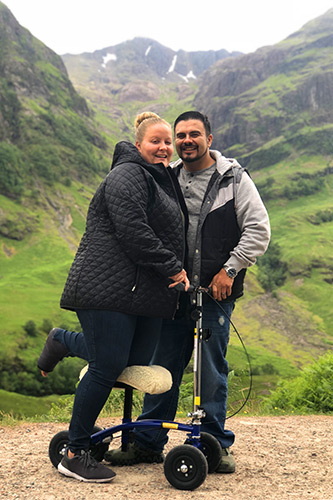
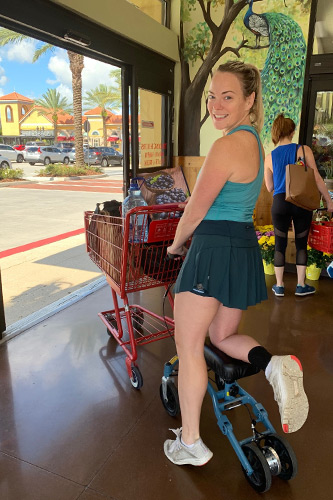
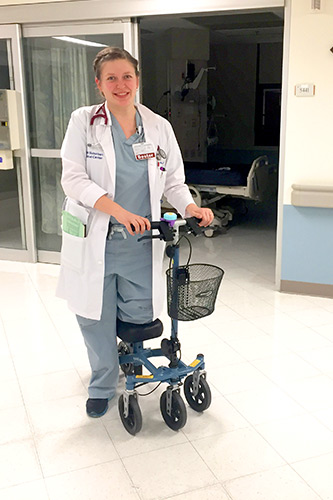
A knee walker is often preferred over crutches because they're cumbersome to use. Irritation under the arms and the need to use both hands makes it difficult to do simple tasks—like opening doors or holding objects while you move around. But more on this later.
Injuries Knee Scooters are Used For
Different accidents and health conditions require patients not to place any weight on their injured foot during rehabilitation. Overall, any below the knee injury can benefit from the use of a knee walker—given a doctor recommends it.
Depending on your situation, you may be prescribed a non-weight bearing period on your injured leg. This is when knee scooters come in handy and allow you to rest your leg on a comfortable knee pad while enabling you to move around with ease—whether at home or work.
These are some common conditions and injuries that require a non-weight bearing recovery period.
Among these conditions:
Achilles tendon rupture, ankle arthritis, ankle fusion surgery, ankle surgery recovery, below the knee amputation, broken ankle recovery, bunion surgery, heel spur surgery, and diabetic foot conditions.
Benefits of Using a Knee Scooter
A knee walker is a modern recovery aid solution. Its primary function is to give you the ability to move around comfortably with ease. A lot of features have been introduced with time, allowing for additional and improved benefits.
A few benefits are:
RELATED: Knee Walker Success Stories
Are Knee Scooters Better Than Crutches?
The answer is a resounding, yes!
These days, crutches are utterly outdated. Knee scooters are a modern-day solution that helps people move around with far more ease compared to the pain, discomfort, and physical exertion of using crutches. Knee walkers allow you to cover significantly more distance comfortably. You can only get so far with crutches before your upper body gives out. They can also be difficult (if not impossible) to use for people with health problems such as arthritis.

When using crutches, it's difficult to carry items with you. Many knee walkers come with a nifty basket so you can carry along items. You can also "park" your scooter (by locking your brakes, so they stay locked), giving you the ability to freely use your arms to, for example, reach into a cabinet.
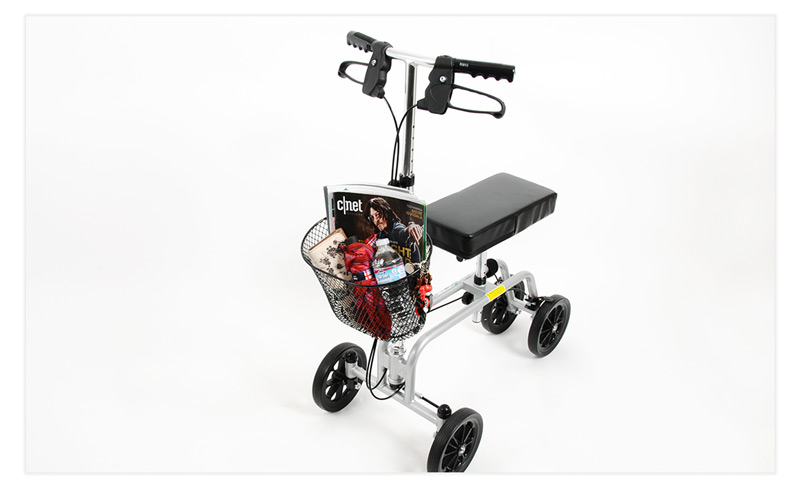 Attachable knee scooter baskets allow you to carry items with you.
Attachable knee scooter baskets allow you to carry items with you.
And if you're one who can't live without a good cup of coffee or tea, you have the option to add a cup holder to your scooter!
In conclusion, knee walkers are not only practically superior to crutches, but they are also more fun.
RELATED: How to Decorate your Knee Scooter
How to Properly Use a Knee Scooter
Using a knee walker could not be easier. Essentially, this is the way it works: You rest your injured foot on the padded knee rest. Grab on to both handlebars. Then, you push yourself forward with your good foot. As you move, use the hand-brakes as needed (the same as bicycle brakes).
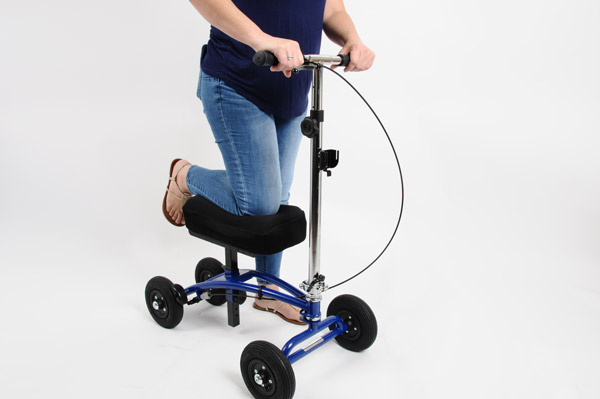
Knee walkers must first be adjusted and measured appropriately to each person's height. The height of the knee pad and the steering column are the most important things to have set correctly. This is very important to ensure maximum comfort and stability when using. We have a excellent guide that goes into more detail.
RELATED: How to Measure For Your Knee Walker
Mainly, the handlebars should be set at a comfortable distance in front of your body, generally about waist height. Your hips should be even, and your good foot placed flat on the floor. Your posture should be upright, not hunched over the unit or leaning back.
After adjusting, you can now get on the walker. But before you do, you must engage and lock the brakes.
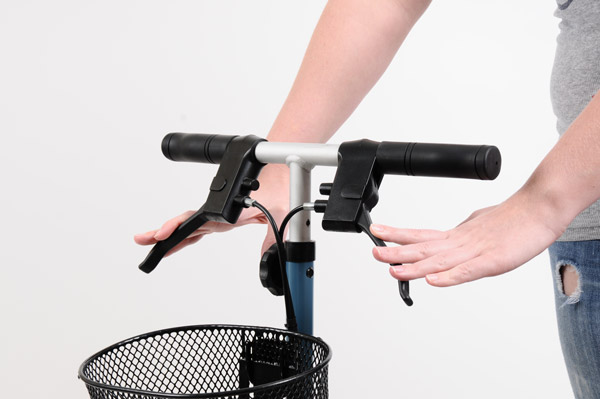 Locking the brakes on a Swivelmate knee walker by TKWC INC®
Locking the brakes on a Swivelmate knee walker by TKWC INC®
Using the brakes will provide you with stability while you mount. Put both your hands on the handlebars, then mount the scooter from one side while placing your injured foot carefully over the knee rest.
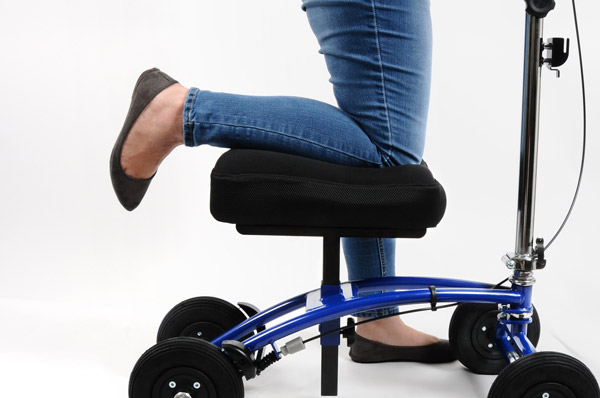
Once you are set and comfortable, you can disengage both brakes.
To move forward, use your good food to push yourself. Start to get comfortable with the scooter slowly, then you can work up to moving at a normal walking speed.
Always make sure to engage and lock the brakes when getting off and on the scooter. Make sure you do so over a stable surface. Avoid slippery surfaces, wet spots, inclines and declines etc.
While you're first getting used to the knee walker, test out the brakes, so you get a feel their braking ability. The brakes are designed to reduce the speed slowly, not to stop you abruptly.
We will cover the topic of how to use a knee walker in an in-depth, step-by-step guide in a future post.
While a scooter allows you to move freely again, you must not abuse its capabilities.
Knee Scooter Safety Tips
With great freedom comes great responsibility. Knee scooters are there to aid you during recovery, not get you injured again. There are a lot of pictures and videos out there of people misusing the scooters—it's just an accident waiting to happen.
It's very important to follow some essential safety tips. Among these are:
Do Knee Scooters Work on Carpets?
All knee scooters can be used on any surface: carpets, concrete, hard and floors, light dirt—and even light snow. All-terrain models are better suitable for moving through rougher surfaces such as grass, dirt, and uneven concrete.
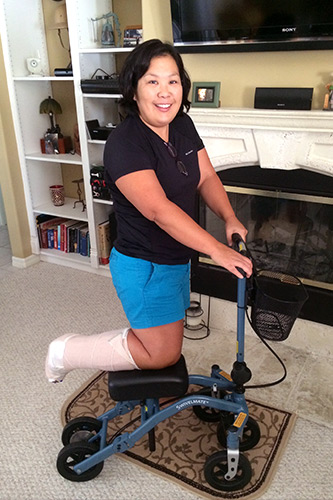
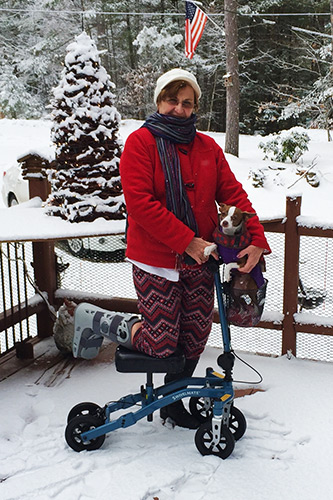
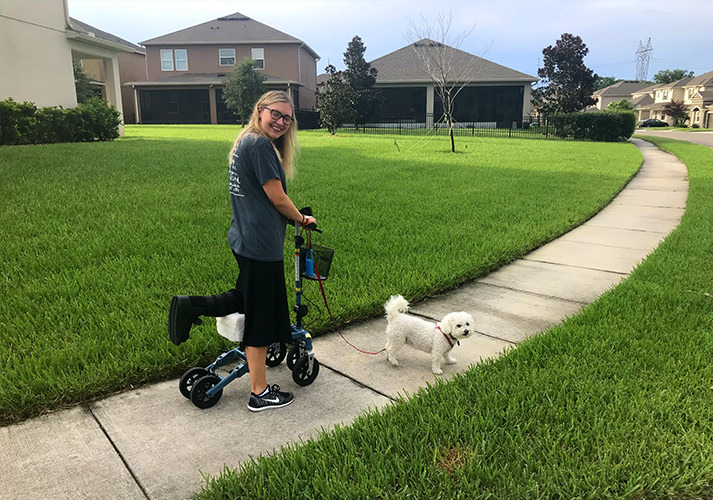
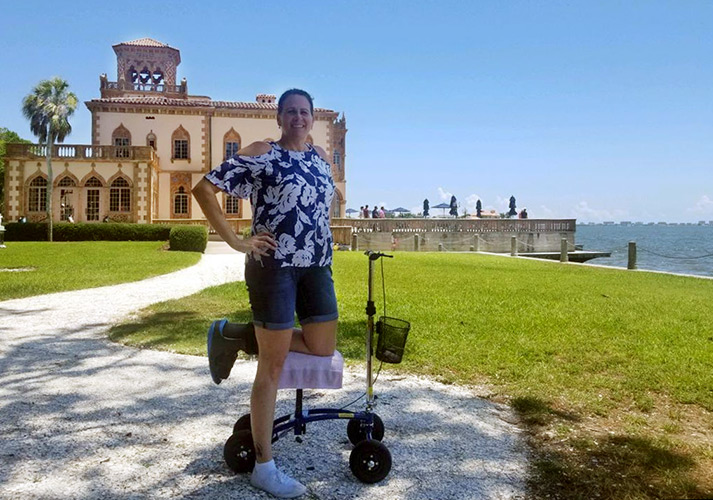
Transitioning between surfaces requires some caution. Approach the surface transition slowly, rolling over the transition between two surfaces can cause bumps or a sudden increase or decrease of speed.Some surfaces will require different effort (because of friction) when you push yourself forward.
Related: Household Chores On A Knee Walker
What is the Best Knee Scooter?
You may be wondering, what is the best of the best?
Here's the thing...
The best knee scooter is the one that best suits your specific needs. You must choose a knee scooter that will fit your budget, lifestyle and the activities you partake in.
There are mainly three types of scooters: standard, specialized and orthopedic.
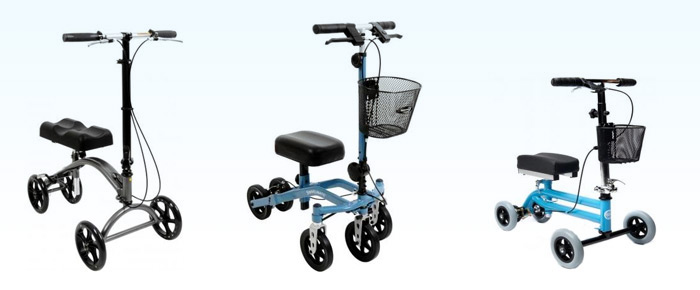 Knee scooter types: standard, specialized, and pediatric.
Knee scooter types: standard, specialized, and pediatric.
A standard knee walker model is a good fit for people who need a knee scooter to simply help them get around the house. You'll be able to get through your home or office and maneuver comfortably.
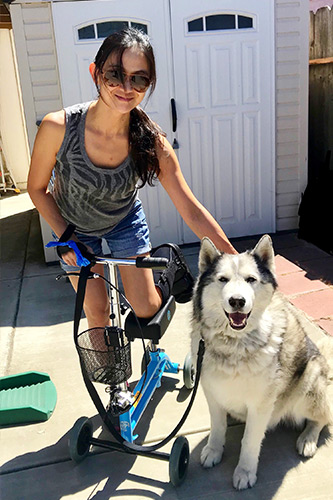
There are more specialized models with enhanced capabilities. An all-terrain model, is the choice for people who like to explore the outdoors. These scooters have bigger, air-filled tires with more rubber to help navigate through a multitude of rough surfaces. They are designed to roll easily over dirt, concrete, grass, and even light snow!
A model like Swivelmate Knee Walker by TKWC INC® can allow you to make tight turns and navigate easily through tight spaces. This is especially helpful in smaller spaces like kitchens and bathrooms, it greatly reduces the amount of 3-point turns needed to navigate around furniture with regular knee walkers. This knee walker has twin hand brakes that lock easily and quickly for when you need to use both your hands. People with very specialized jobs and hobbies prefer these.
 Some scooter models allow you to engage "parking brakes" providing stable support while you perform your activities.
Some scooter models allow you to engage "parking brakes" providing stable support while you perform your activities. Locking the brakes enables the scooter to "park" for when you need the use of both your hands.
Locking the brakes enables the scooter to "park" for when you need the use of both your hands.
Pediatric scooters are also available for children or individuals less than 5'5". They're also built sturdy and lightweight with all the same standard features as standard knee walkers.

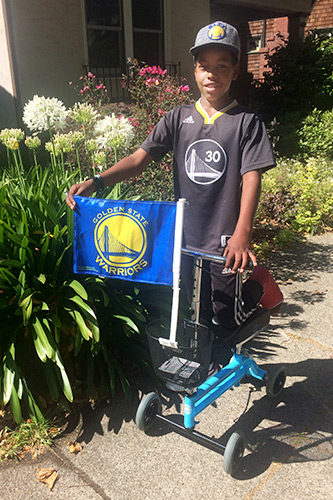
When deciding on a knee scooter that is right for you, here are some things to consider:
Can I Travel with a Knee Scooter?
Indeed, you can! You can easily take it with you in cars, planes, and cruises. If you foresee doing some traveling, foldable models will be a good fit. If traveling on taxis, Uber/Lyfts, subways, trains, or buses, the units can fold and stow away easily.
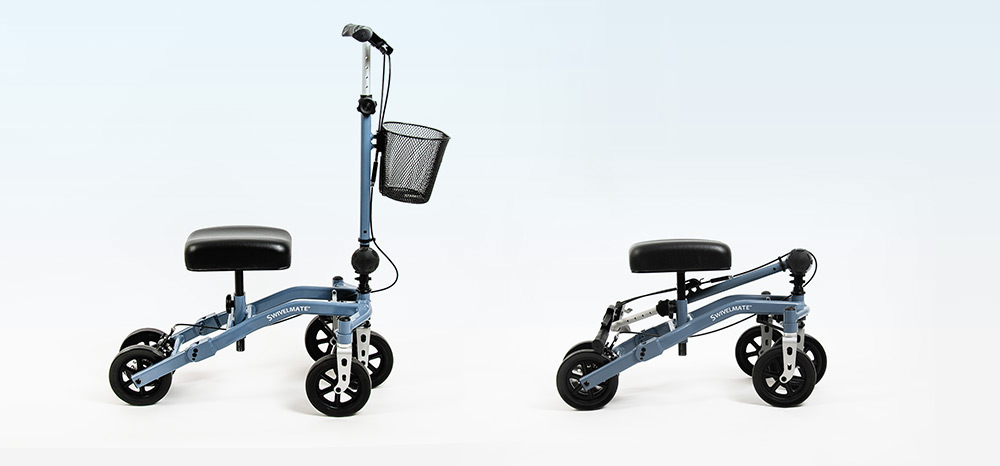 Some scooter models have easy folding capabilities for easy storage or transport.
Some scooter models have easy folding capabilities for easy storage or transport.
Airlines treat knee walkers like any other piece of medical equipment, and they will accommodate you accordingly. You can read more in-depth about traveling with scooters below.
RELATED: Traveling with a Knee Scooter
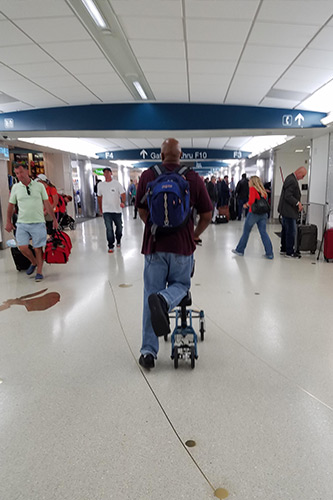
How Much is a Knee Scooter?
Generally, the purchase cost range for knee walkers is from $125 to $400; it all depends on the specific model you need. Obviously, the most expensive models will have more features and capabilities.
Another great alternative to purchasing a knee walker is to rent one. You can rent one online for a little as $30 per week and have it shipped anywhere (we ship free both ways). This is a service we provide, which is the most competitive on the market today.
It's necessary first to figure out what your needs are, and then you can narrow down on the kind of scooter best suited for you. Think about the questions on the What is the Best Knee Scooter section of this article. Do you need a simple barebones scooter, all-terrain model, or specialized one?
We have an excellent guide you can use to help you choose the appropriate knee scooter for you. Furthermore, you can contact us , and we will happily answer any questions you have.
Does Insurance Cover Knee Scooters?
The short answer is, it depends on your provider. Lets explore some options.
While Medicare does cover durable medical equipment (DME), we have learned from customers that it does not cover the cost of a knee scooter—even despite knee scooters being classified as a DME. Medicare regards them as luxury items because they argue crutches do precisely the same thing, thus their reason for not covering them. But as we clearly explained, crutches are an antiquated solution to mobility during injuries.
Medicaid may cover them, but it will depend on your specific policy. You will have to consult with them first.
If you have a private insurance policy, some companies will cover the cost of rental or purchase—again, it will depend on your specific policy. Check with your insurance company to see if they can cover it.
At Rent A Knee Walker, we accept most FLEX and Health Saving Account Credit Cards for your knee walker rental. As long as there is a Visa or MasterCard logo on the card, it can be used in the checkout process as a regular credit card.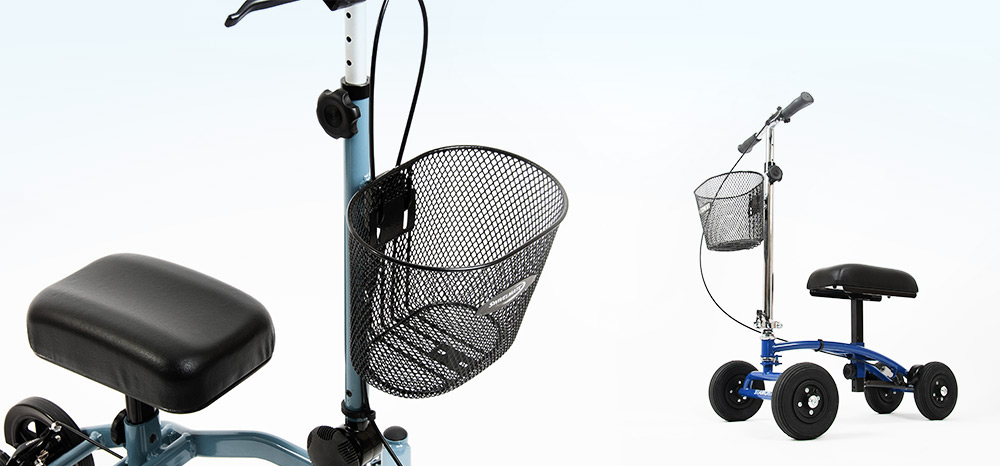
We've covered all the most commonly asked questions on the subject of knee scooters.
We hope this guide gave you a thorough understanding of what knee walkers are and why they are a modern and essential aid to someone's leg injury recovery process.
If you have any further questions, check out the links included this article for more detailed information.
You can always reach out to us and speak with a member of our team. We are always happy to help!Ready for a Knee Walker? I want to... I want to... orChoose this if you'll need it for
6 weeks or lessChoose this if you'll need it for
more than 6 weeksI already have a knee walker
More Great Rent A Knee Walker News & Stories
- •
- •
- •
- •
- •

